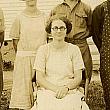
Women on the Ridge
by Cindy Laug
published: March 31st, 2011
The Peach Ridge Fruit Growers Association, formed in 1928, grew mostly peaches as the name implied. The Ridge, as it is still known, is an elevation of land 20 miles from south to north and 10 miles east to west. It includes land west of the Grand River, bordered on the North by Bailey Road, the south by Leonard St., and a line passing through Coopersville and Ravenna to the west. But farmers on the Ridge discovered the soil and climate worked well for growing apples, also. They set their orchards in a diamond pattern alternating peach and apple trees. Peach trees matured and died off in about 10 years whereas apple trees would continue to grow for as many as 30 or 40 years. Once the peach trees died off the open space allowed the apple trees to grow and fill-in. Over time the peach ridge farmers’ crop also included apples. To market their product they needed to convince consumers that apples were not just a fresh snack. (Find more information to your right in Related Items)
Aleta "Leta" Elizabeth Vogel, born 1902, was raised on the family farm on 8 Mile Road just west of Alpine Ave. just north of Grand Rapids. Like many farms during those years they raised a little of everything including fruit. She became a teacher and taught at Boyd School, the one room school on the corner of Fruit Ridge and 8 Mile Road. Her husband Jarvis "Jack" Brown, born and raised on the family farm just down the road from Boyd School, became a factory worker. Shortly after their marriage in the mid-1920s they decided to change professions.
With a background in fruit, the Browns started their wholesale fruit business on 2nd St. in Grand Rapids during 1927. They eventually expanded and started selling from a garage on the corner of Leonard and Walker NW. They traveled to individual orchards, helped sort the apples right in the barns, loaded the bushel baskets onto their truck, and moved to the next farm. Later they added another truck and the business continued to grow. They sold apples directly to local grocers from their market site.
Ginny Ebers only responsibility on the farm, prior to the death of her husband Rocky, was raising the children. During the fall harvest of 1969 Rocky was having trouble with apple bruising caused by rough handling and asked Ginny to help. She only had to walk through the orchards and look in the boxes; not a word was spoken. Her oversight was all that was needed to reduce the percentage of bruising. Nothing prepared Ebers to assume the full burden of operating the orchard after Rocky's sudden death, from a brain tumor, in January 1970. They had been married 9 years, and her children were 6 and 7 years old.
Ginny was fortunate to have longtime orchard manager, Everett Shue who knew the spray program, was the apple tree expert, and helped guide the harvest process with brother-in-law, Jim Badgerow. By Fall 1972 Ginny's 200 acre farm, with 8000 apple trees, 2000 prune trees, and 150 cherry trees, employed about 50 seasonal workers. Keeping the equipment running and the farm afloat were not always easy.
Connee Canfield, the wife of a pickle farmer from Keeler, Michigan, founded WSAM (Women for the Survival of Agriculture in Michigan) in 1972 by. In September of that year farm wives in southwest Michigan picketed a local apple juice processor because he under-paid apple farmers in Coloma. The women encouraged farmers to withhold delivery to the processors without a fair price. Four women from the Ridge went down to march in support. They returned home and began planning to do the same. They formed a ladylike picket line, and all wore white gloves as a symbol of remaining orderly.
"I like farming and so does my husband. I love my husband, and I will do what I have to do to assure he can continue to do what he loves," said Sharon Steffens. The year was 1972 and the newly formed WSAM had just organized the "ladylike" picket of area fruit processors who were underpaying apple farmers on the Ridge. It was just the beginning of a movement of women stepping out of the kitchens, orchards, and farms to support family farms in a very different way. Women in agriculture were an untapped resource and they were fearsome.
Sharon, raised in the city, a music teacher by profession, a mother of five, and an activist by nature had found her niche. She could do the organizing, and changing legislation was the answer. As the first state chairperson of WSAM Sharon believes many farm problems stem from state houses and the U.S. Congress where "too many urban oriented people" make decisions for agriculture. "It is time farmers and farm wives get in on the ground floor of governmental decision making in areas like land use, land taxes, pesticide use, feedlot regulation and even the farmers' average age."
The Apple Smorgasbord began as a grower's picnic to build community among the Peach Ridge Fruit Growers Association. The men would share their wives' apple recipes to assemble a full buffet of foods each incorporating locally grown apples. They held the first event in 1951 at the William Schaefer farm on the second Tuesday in September when harvest was in full swing and the trees would be laden with fruit. Holding the event at a local farm brought people into the orchard setting. With this concept in mind, it was suggested to invite people who could help promote their abundance of apples and their industry.
The organizers collected names of food editors, reporters and media, local food stores, government officials both local and state, and anyone who had influence over the industry. The Apple queen, who was always present, mingled with the crowd and passed out the featured apple candy. There were tours, exhibits, entertainment, and apple fritters fresh fried while you wait. Refreshing apple juice with floating crab apples was a favorite along with apple butter made in a large copper kettle over an open fire. The buffet held over 200 homemade apple dishes.

West of the Grand River was home of the Peach Ridge Growers Association formed in 1928. Farmers found the peachy soil to be just right for growing apples. The first apple smorgasbord was held in 1951 to build community through a growers picnic where attendees could enjoy apple fritters and apple butter.
Bibliography
Books Available from the History & Special Collections Dept., Grand Rapids Public Library
- Alberts, Francis. A Collection of Stories About Alpine Township. 1998
- Alt, Mary Rasch. Alpine Township. Arcadia Publishing, 2007
- Madison, Barbara. The Ridge: The People, the Place, the History. 1992
- O’Commor, Jennifer. Preserving Alpine: An Inventory of Alpine Township Public Cemetery. 1999
- Wier, David. 150 Year of Alpine Township History. Alpine Historical Commission, 1997
Websites

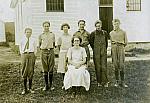

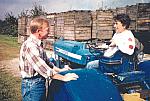
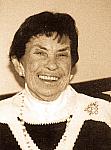
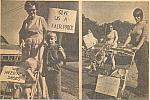
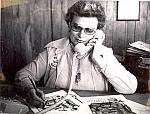
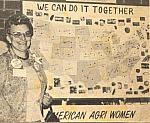
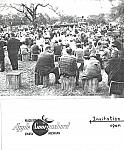

 facebook
facebook